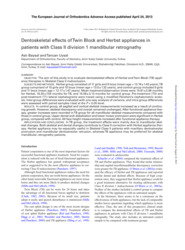Dentoskeletal effects of Twin Block and Herbst appliances in patients with Class II division 1 mandibular retrognathy
-
Eser Sahibi
ASLI BAYSAL
-
Görnüş
Makale
- Neşir senesi 2014
-
Publisher
European Orthodontic Society
- Iňleýin Görnüşli Salgysy Http://hdl.handle.net/11469/170
-
Konu Başlıkları
Dentoskeletal effects of twin block
Herbst appliances
OBJECTIVE: The aim of this study is to evaluate dentoskeletal effects of Herbst and Twin Block (TB) appliance therapies in Skeletal Class II malocclusion.
SUBJECTS AND METHODS: Herbst group consisted of 11 girls and 9 boys (mean age = 12.74±1.43 years), TB group comprised of 10 girls and 10 boys (mean age = 13.0±1.32 years), and control group included 9 girls and 11 boys (mean age = 12.17±1.47 years). Mean treatment/observation times were 15.81±5.96 months for Herbst, 16.20±7.54 months for TB, and 15.58±3.13 months for control group. Pre-treatment (T0) and post-treatment (T1) lateral cephalograms were traced using a modified Pancherz’s cephalometric analysis. Inter-group differences were evaluated with one-way analysis of variance, and intra-group differences were assessed with paired samples t-test at the P < 0.05 level.
RESULTS: In control group, all sagittal and vertical skeletal measurements increased as a result of continuing growth. However, skeletal discrepancy and overjet remained unchanged. After functional appliance therapy, greater increases were recorded in TB group for all mandibular skeletal measurements compared with those in control group. Upper dental arch distalization and lower incisor protrusion were significant in Herbst group, compared with control. All face height measurements increased after functional appliance therapy.
IMPLICATIONS AND CONCLUSIONS: In TB group, the treatment effects were mainly due to mandibular skeletal changes. Both skeletal and dental changes contribute to Class II correction with Herbst appliance therapy. Herbst appliance may be especially useful in Skeletal Class II patients with maxillary dentoalveolar protrusion and mandibular dentoalveolar retrusion, whereas TB appliance may be preferred for skeletal mandibular retrognathy patients.
-
Koleksiyonlar
FAKÜLTELER
DİŞ HEKİMLİĞİ FAKÜLTESİ
KLİNİK BİLİMLER BÖLÜMÜ

 Tam Metin
Tam Metin

